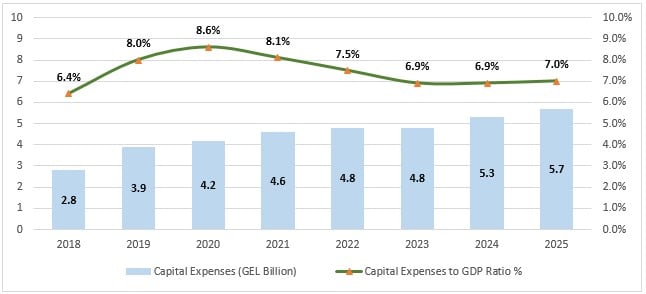Giorgi Kakauridze: “Current expenditures are returning to the pre-pandemic 22%. We have not cut capital expenses – they were within the margin of 8% before the pandemic, 9% in 2020, 8.2% in 2021 and they are quite high for the next year at 8.5%.”
Verdict: FactCheck concludes that Giorgi Kakauridze’s statement is FALSE.
Resume: According to the draft budget submitted to the Parliament of Georgia, the general budget’s [1] current expenditures amount to 25.2% of the GDP for 2021. According to the 2022 plan, that figure will decrease to 23% and further to 22.1% for 2023. Therefore, the statement of the Deputy Minister of Finance is incorrect. On the one hand, the capital expenditures to the GDP ratio in the pre-pandemic (2018-2019) years were 21.3%-21.4% instead of 22% whilst on the other hand, it is planned to cut current expenditures to 21.4% only for the year 2025, meaning in two years after reaching 22%. Giorgi Kakauridze, by exaggerating the pre-pandemic figure, artificially seeks to show the date of returning to that same figure is closer than it actually is.
In 2019, capital expenses amounted to 8% of the GDP which increased by 0.6 of a percentage point; that is, to 8.6% of the GDP (instead of 9%) in 2020 whilst it is planned that capital expenses will reach 8.1% in 2021. However, according to the budget, the capital expenses to the GDP ratio will drop to 7.5% by 2022 and it is planned to further cut that figure to 7% for 2023-2025. Therefore, the basis of the part of Giorgi Kakauridze’s statement where he speaks about the growth of capital expenses is unclear. It is planned to have the capital expenses to the GDP ratio at 7.5% for 2022 instead of 8.5% as named by the Deputy Minister of Finance. However, even if we assume that naming that figure (8.5%) was a mechanical error, the essence of Mr Kakauridze’s statement contradicts the Country Basic Data and Directions Document submitted to the Parliament of Georgia which clearly outlines that cutting of the capital expenses to the GDP ratio to 7-7.5% is a significant challenge.
In essence, the statement of the Deputy Minister of Finance is far from the real picture, it contradicts the official document submitted to the Parliament of Georgia and his figures do not match with those given in the official data.
Analysis:
The Deputy Minister of Finance of Georgia, Giorgi Kakauridze, whilst presenting the initial draft budget to the parliamentary committee, stated: “[In the case of the] current expenditures in the general budget we are slowly returning to the pre-pandemic 22% figure. In fact, we have not cut capital expenses – in a year prior to the pandemic they were within the margin of 8%, 9% in 2020, 8.2% this year [2021] and 8.5% for the next year [2022].”
The current expenditures of the general budget consist of labour remuneration, the purchase of goods and services, interest rates payables, subsidies, grants, social security and other expenses. Capital expenses are the growth of non-financial assets (infrastructural expenses). Capital infrastructure is critical for the development of Georgia. Therefore, the growth of the capital expenses to the GDP ratio is important. On the other hand, given the aims to limit the size of the government, a higher expenses to the GDP ratio is naturally undesirable. Of note is that according to the draft Law on Economic Freedom, total amount of current expenditures and the capital expenses to the GDP ratio should have been capped at 30%. In 2014-2017, this requirement was breached every year and it was abolished altogether after legislative changes enacted in 2018.
Table 1 shows the dynamic of the general budget’s current expenditures to the GDP. Given the pandemic, the general budget’s current expenditures in 2020 increased by 4.8 percentage points as compared to 2019 which was a result of the growth of pandemic-related expenses. According to the 2021 forecasts, the general budget’s current expenditures to the GDP ratio is 25.2% whilst this figure will decrease by 23% according to the 2022 planned budget. In accordance with the plan, current expenditures will come back to the pre-pandemic dynamic by 2023-2025. The growth in current expenditures as compared to the pre-pandemic period is largely stipulated by increased social assistance and subsidies. If the anticipated dynamic is carried through, the current expenditures will continue a decreasing trend as per Giorgi Kakauridze’s statement.
Table 1: Current Expenditures Percentage Dynamic Vis-à-vis GDP in 2018-2025

Source: Ministry of Finance of Georgia
Graph 1 shows the dynamic of the capital expenses. In 2019, capital expenses amounted to 8% of the GDP which increased by 0.6 of a percentage point; that is, to 8.6% of the GDP in 2020. However, according to the plan, the capital expenses to the GDP ratio will drop to 7.5% by 2022 and there are plans to further cut this figure to 6.9% for 2023-2025. Therefore, the basis of the part of Giorgi Kakauridze’s statement where he speaks about the growth of capital expenses is unclear. It is planned to have the capital expenses to the GDP ratio at 7.5% for 2022, instead of 8.5% as named by the Deputy Minister of Finance.
Graph 1: Dynamic of the Capital Expenses in 2018-2025, According to the Draft Budget

Source: Ministry of Finance of Georgia
Even if we assume that naming that figure (8.5%) was a mechanical error, the essence of Giorgi Kakauridze’s statement contradicts the Country Basic Data and Directions Document submitted to the Parliament of Georgia which clearly outlines that the cutting of the capital expenses to the GDP ratio to 7-7.5% is a significant challenge.
[1] Consolidated budget of the Georgian state budget, republican budgets of autonomous republics and the budgets of municipalities. The general budget is not a subject of approval of any of the representative bodies of the authorities.








